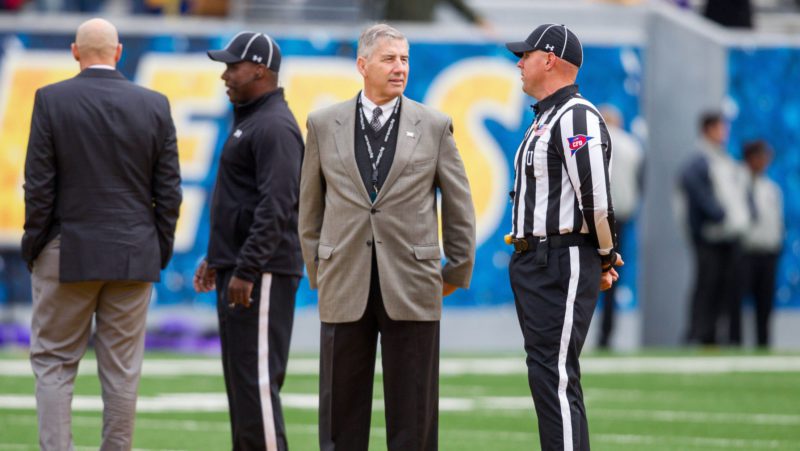Football
Where Does the Big 12 Rank in Conference Revenue?

By: Kyle Cox and Kyle Porter
In case you didn’t know, college football is big business. Between TV money (now called media rights), revenue from bowl games and the CFP games themselves, Power 5 conferences and schools are raking it in hand over fist.
When looking at conference earnings, there are a couple of things to consider. Different conferences have different rules about how money is distributed and what money is considered part of a school’s distribution (i.e. who controls third-tier media rights).
For our purposes, we will stick to money distributed strictly from the conferences to their institutions. It does not include, for example, the $15 million Texas makes per year on the Longhorn network or the substantial amount of money Oklahoma State makes on its third-tier rights (presumed to be around right around $6 million).
Here’s a look at how each conference ranks income distribution. It should be noted that only the SEC and Big 12 have reported numbers for the 2015-16 fiscal year. There are all sorts of caveats in these numbers (i.e. Notre Dame is considered “part” of the ACC but only gets around 1/4 of what the other schools get), but these numbers represent the average of what most teams received.
| Conference | FY 2015 Payout | FY 2016 Payout |
|---|---|---|
| SEC (Reference) | $32.7M | $40.4M |
| Big 10 (Reference) | $32.4M | |
| ACC (Reference) | $26.2M | |
| Big 12 (Reference) | $25.2M | $30.4M |
| Pac 12 (Reference) | $25.1M |
SEC
In 2012, the SEC was the first conference to hit the $20 million range for yearly distribution to its schools. Five years later, that number has doubled. SEC schools will receive approximately $40.4 million each based on a report from Yahoo Sports.
While the SEC is by far the highest earner, the gap looks like it’s about to close significantly.
Big 10
The Big 10 scored a big pay day last year as it secured $440 million per year from ESPN and FOX for the next six years. Preposterous money. This was made possible by a somewhat brash move to sign a six-year contract the last go around as opposed to a more stable long-term deal. The rest of the Power 5 is still tied up until at least 2020.
The Big 10 bet on itself and the continued escalation of first-tier dollars.
Big 12
So the Big 12 actually currently ranks second in payouts to individual schools at $30.4 million after a roughly $50 million jump in overall revenue between 2015 and 2016. Of course, three of the other leagues haven’t reported 2016 revenue yet.
The league’s overall distribution has traditionally been behind all other Power 5 conferences but the pot is being split up between 10 schools instead of 12 like the Pac-12 or 14/15* like the SEC, Big 10 and ACC.
Also of note, last season was the first year that TCU and West Virginia received equal distributions. The above number does not reflect the 25 percent withholding that Baylor has been slapped with by the Big 12.
With efforts to expand the league shelved and the continued television network-sized elephant in the room, the long term future of the Big 12 is uncertain. As it sits now, the league will gain up to an additional $30 million for the resurrection of the championship game starting in 2017.
“Oh, I think they’re going to be here for a long time,” OU president David Boren said last year. “I won’t be but the conference is going to outlive me, I’m sure of that.”
Pac-12
The Pac-12 came in last in per school distribution at $25.1 million for FY 2015. Not great. And the news doesn’t get better.
ACC
The ACC rounds out the Power 5 schools. On their last deal, the ACC also made the curious move of including all third-tier media rights in the deal with ESPN — essentially giving them away. That deal was recently re-negotiated, though, and should provide a boost to this conference.
It will be interesting to watch how the market for college sports media evolves over the next three-plus years. A lot can change in that time. Back in 2012, the future of cable TV networks looked as steady as Phil Forte’s free-throw motion. Now as more and more people chose to unplug and look for streaming and on demand solutions for their sports-watching needs, the landscape will continue to change.
And it will be interesting to see how the payouts look in a few months when the rest of the 2016 numbers roll in and even a few FY 2017 numbers.
One thing is for sure, the demand for college football isn’t going anywhere.

-

 Football3 days ago
Football3 days agoFour-Star Quarterback Adam Schobel Commits to Oklahoma State, Flips from Baylor
-

 Hoops3 days ago
Hoops3 days ago‘Keep Turning Over the Rocks’: Looking at the Portal Landscape as Lutz Looks to Solidify His First OSU Roster
-

 Hoops3 days ago
Hoops3 days agoFour-Star Signee Jeremiah Johnson Reaffirms Commitment to Oklahoma State after Coaching Change
-

 Daily Bullets3 days ago
Daily Bullets3 days agoDaily Bullets (Apr. 23): Pokes Land Four-Star Quarterback, Retain Talent from Mike Boynton Era






